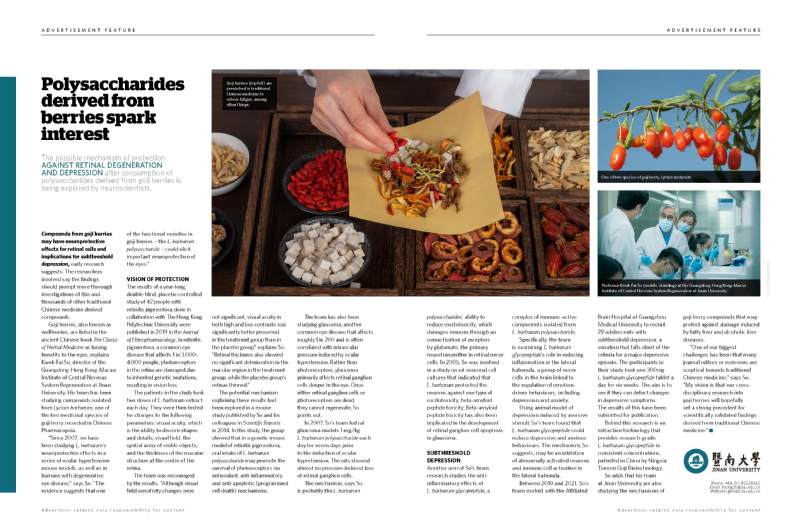The possible mechanism of protection AGAINST RETINAL DEGENERATION after consumption of polysaccharides derived from goji berries is being explored by neuroscientists.

Compounds from goji berries may have neuroprotective effects for retinal cells and implications for subthreshold depression, early research suggests. The researchers involved say the findings should prompt more thorough investigations of this and thousands of other traditional Chinese medicine derived compounds.
Goji berries, also known as wolfberries, are listed in the ancient Chinese book The Classic of Herbal Medicine as having benefits to the eyes, explains Kwok-Fai So, director of the Guangdong-Hong Kong-Macau Institute of Central Nervous System Regeneration at Jinan University. His team has been studying compounds isolated from Lycium barbarum, one of the two medicinal species of goji berry recorded in Chinese Pharmacopeia.
“Since 2007, we have been studying L. barbarum’s neuroprotective effects in a series of ocular hypertension mouse models, as well as in humans with degenerative eye disease,” says So. “The evidence suggests that one of the functional moieties in goji berries − the L. barbarum polysaccharide − could elicit important neuroprotection of the eyes.”
VISION OF PROTECTION
The results of a year-long, double-blind, placebo-controlled study of 42 people with retinitis pigmentosa done in ollabration with The Hong Kong Polytechnic University were published in 2019 in the Journal of Ethnopharmacology. In retinitis pigmentosa, a common eye disease that affects 1 in 3,000-4,000 people, photoreceptors in the retina are damaged due to inherited genetic mutations, resulting in vision loss.
The patients in the study took two doses of L. barbarum extract each day. They were then tested for changes to the following parameters: visual acuity, which is the ability to discern shapes and details; visual field, the spatial array of visible objects; and the thickness of the macular structure at the centre of the retina.
The team was encouraged by the results. “Although visual field sensitivity changes were not significant, visual acuity in both high and low contrasts was significantly better preserved in the treatment group than in the placebo group,” explains So. “Retinal thickness also showed no significant deterioration inthe macular region in the treatment group, while the placebo group’s retinas thinned.”
The potential mechanism explaining these results had been explored in a mouse study published by So and his colleagues in Scientific Reports in 2014. In this study, the group showed that in a geneticmouse model of retinitis pigmentosa, oral intake of L. barbarum polysaccharide may promote the survival of photoreceptors via antioxidant, anti-inflammatory and anti-apoptotic (programmed cell death) mechanisms.
The team has also been studying glaucoma, another common eye disease that affects roughly 1 in 200 and is often correlated with intraocular pressure induced by ocular hypertension. Rather than photoreceptors, glaucoma primarily affects retinal ganglion cells deeper in the eye. Once either retinal ganglion cells or photoreceptors are dead,they cannot regenerate, So points out.
In 2007, So’s team fed rat glaucoma models 1 mg/kg L. barbarum polysaccharide each day for seven days prior to the induction of ocular hypertension. The rats showed almost no pressure-induced loss of retinal ganglion cells.
The mechanism, says So, is probably the L. barbarum polysaccharides’ ability to reduce excitotoxicity, which damages neurons through an overactivation of receptors by glutamate, theprimary neurotransmitter in retinalnerve cells. In 2005, So was involved in a study on rat neuronal cell cultures that indicatedthat L. barbarum protected the neurons against one type of excitotoxicity, beta-amyloid peptide toxicity. Beta-amyloid peptide toxicity has also been implicated in the development of retinal ganglion cell apoptosis inglaucoma.
SUBTHRESHOLD DEPRESSION
Another arm of So’s brain research studies the anti- inflammatory effects of L. barbarum glycopeptide, a complex of immune-active components isolated from L. barbarum polysaccharide.
Specifically, the team is examining L. barbarum glycopeptide’s role in reducing inflammation in the lateral habenula, a group of nerve cells in the brain linked to the regulation of emotion- driven behaviours, including depression and anxiety.
Using animal model of depression induced by aversive stimuli, So’s team found that L. barbarum glycopeptide could reduce depressive and anxious behaviours. The mechanism, So suggests, may be an inhibition of abnormally activated neurons and immune cell activation in the lateralhabenula.
Between 2019 and 2021, So’s team worked with the Affiliated Brain Hospital of Guangzhou Medical University to recruit 29 adolescents with subthreshold depression, a variation that falls short of the criteria for a major depressive episode. The participants in their study took one 300mg L.barbarumglycopeptidetableta day for six weeks. The aim is to see if they can detect changes in depressivesymptoms.The results of this have been submitted for publication.
Behind this research is an extraction technology that provides research-grade L. barbarum glycopeptide in consistent concentrations, patented in China by Ningxia Tianren Goji Biotechnology.
So adds that his team at Jinan University arealso studying the mechanisms of goji berry compounds that may protect against damage induced by fatty liver and alcoholic liver diseases.
“One of our biggest challenges has been that many journal editors or reviewers are sceptical towards traditional Chinese medicine,” says So. “My vision is that our cross- disciplinary research into goji berries will hopefully set a strong precedent for
https://www.nature.com/collections/aeicdaeegi


